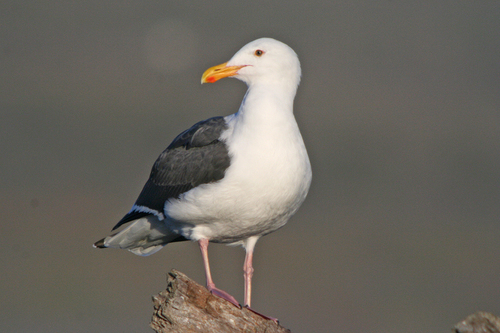
Western Gull
The Western Gull (*Larus occidentalis*) is a large, robust gull found along the Pacific Coast of North America. It plays a significant role in the coastal ecosystem as both a predator and scavenger, helping to regulate populations of smaller animals and clean up carrion. While not particularly celebrated in popular culture, it is a familiar sight to coastal residents and a key component of the region's biodiversity. Its adaptability has allowed it to thrive even in urbanized areas, often nesting on rooftops and foraging in landfills.
55-68 cm
Length
130-144 cm
Wingspan
Least Concern
Conservation Status
Distribution
Primarily found along the Pacific Coast of North America, from southern British Columbia in Canada down to Baja California in Mexico. It is largely non-migratory, although some individuals may disperse shorter distances north or south after the breeding season. It is rarely found far inland.
Lifespan
Typically 10-15 years in the wild, but can live longer (up to 25 years or more recorded).
Western Gull's Habitat
Habitat Types
Rocky coastlines, Sandy beaches, Estuaries, Offshore islands, Harbors, Landfills (near the coast)
Climate Zones
Temperate, Subtropical
Adaptations
Western Gulls have strong legs and webbed feet for swimming and walking on various substrates. Their robust bills are adapted for a diverse diet. They also possess salt glands above their eyes, allowing them to excrete excess salt from the seawater they ingest.
Variations
Two subspecies are generally recognized: *L. o. occidentalis* (northern) and *L. o. wymani* (southern). The southern subspecies tends to be slightly smaller and darker-backed.
Appearance
Breeding Plumage
Adults in breeding plumage have a white head, neck, and underparts, with a dark gray back and wings. Non-breeding adults develop some dusky streaking on the head and neck.
Seasonal Feather Changes
The main seasonal variation is the presence or absence of head streaking. Juveniles have mottled brown plumage, gradually acquiring adult plumage over 3-4 years.
Sex Based Plumage Differences
There is no significant sexual dimorphism in plumage coloration.
Notable Features
Heavy yellow bill with a red spot on the lower mandible., Dark gray back and wings (mantle)., Pink legs and feet., White tail with a black subterminal band (in adults).
Diet and Feeding
Primary Foods
Fish, Invertebrates (e.g., crabs, mussels, sea stars), Carrion, Garbage, Eggs and chicks of other birds
Foraging Behavior
Western Gulls are opportunistic feeders, employing a variety of foraging techniques. They may forage while walking, swimming, or flying. They often drop hard-shelled prey from a height to break them open. They also scavenge extensively and steal food from other birds (kleptoparasitism).
Specializations
Their strong bill allows them to handle a wide range of prey sizes and types. Their scavenging habits are facilitated by their keen eyesight and ability to locate food sources quickly.
Seasonal Diet Variations
Diet can vary seasonally depending on the availability of prey. For example, during the breeding season, they may focus more on fish and invertebrates to feed their chicks. In winter, they may rely more on scavenging.
Behavior
Social Structure
Western Gulls are highly social, often nesting in large colonies. Outside of the breeding season, they may form large flocks at roosting sites or feeding areas.
Communication
A variety of calls, including a loud 'keow' call., Head-tossing and other visual displays., Aggressive postures to defend territories or food.
Migration
Largely non-migratory, but some individuals, particularly juveniles, may disperse along the coast after breeding.
Territorial or Group Behaviors
During the breeding season, they are highly territorial, defending their nesting site from other gulls and predators. They may also engage in cooperative defense of the colony.
Conservation
Threats
Habitat loss and degradation (coastal development), Pollution (oil spills, plastic ingestion), Human disturbance at nesting colonies, Climate change (sea level rise, changes in prey availability)
Protection Programs
Marine Protected Areas, Regulations to reduce pollution, Monitoring of breeding colonies, Efforts to reduce human disturbance
Local National Laws
Protected under the Migratory Bird Treaty Act in the United States and similar legislation in Canada and Mexico.
Population Trend
Stable
Population Estimates
The global population is estimated to be around 770,000 - 870,000 mature individuals.
Interesting Facts
Western Gulls are known to hybridize with Glaucous-winged Gulls.
This hybridization occurs where their ranges overlap, producing offspring with intermediate characteristics.
They can drink saltwater.
Their salt glands allow them to excrete excess salt, enabling them to survive in marine environments.
They are opportunistic and have adapted their diet to human presence.
Western Gulls have learned to forage in landfills, fishing docks, and other human-altered areas, expanding the range of foods they can consume.
They are one of only a few gull species mostly limited to the Pacific Coast of North America.
This makes them a characteristic species of this region's coastal ecosystem.
Faqs about Western Gull
What is the difference between a Western Gull and a seagull?
'Seagull' is a general term for any gull species. The Western Gull is a specific species of gull.
Are Western Gulls aggressive?
They can be aggressive, especially when defending their nests or competing for food. It's best to give them space, particularly during the breeding season.
Do Western Gulls mate for life?
They typically form pair bonds that last for a single breeding season. While some pairs may reunite in subsequent years, they are not strictly monogamous for life.
How can I tell a Western Gull from other gulls?
Look for the combination of a dark gray back, pink legs, a yellow bill with a red spot, and a white head (in breeding plumage). The size and location are also important clues.
Copyright @ Nature Style Limited. All Rights Reserved.
 English
English